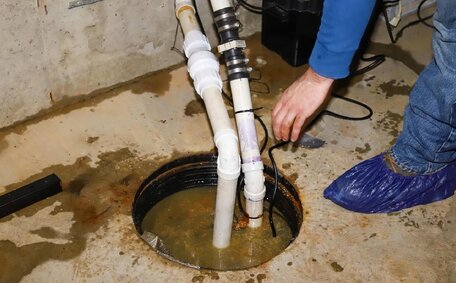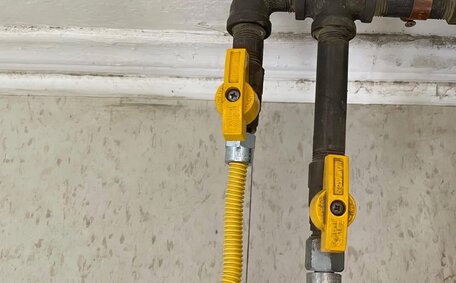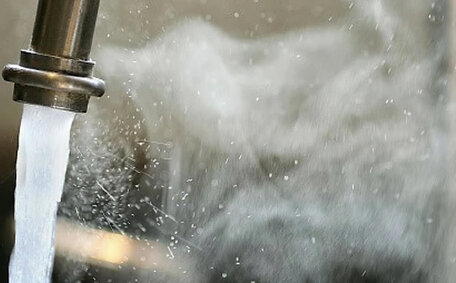What Constitutes a Plumbing Emergency?
A plumbing emergency is a situation where your home’s plumbing system malfunctions, threatening significant water damage unless promptly managed. Common examples, affecting walls and floors, include:
- A burst pipe or leaking pipes
- Blocked drains or sewer lines backing up
- Complete failure of hot water systems
- Gas leaks from appliances or pipework
- Major flooding from fixtures like toilets or water heaters
These incidents might be covered by insurance, providing financial protection against swift water intrusion and subsequent damage to your residence. Plumbing leaks pose health risks due to contamination, mould growth, and slippery surfaces, necessitating immediate attention. Contacting a licensed emergency plumber swiftly upon detecting leaks, backups, or appliance malfunctions is essential to prevent disruption to standard water flow or drainage.
Taking immediate action reduces the risk of damage and underlines the importance of preventative strategies for plumbing complications.
Understanding Your Home Insurance Policy
Home insurance policies provide differing protection levels for plumbing issues, with specific incidents covered according to particular terms and conditions. Although most insurance policies cover sudden events like burst pipes, terms vary and costs can escalate into thousands of dollars due to gradual leaks or maintenance failures.
Homeowners must comprehend the nuances of their insurance plan, including exactly what their policy covers, to avoid assumptions. Key areas to understand include:
- What specific types of plumbing emergencies are covered and which are excluded
- Whether there are dollar limits per claim or annually
- If regular wear and tear is covered
- The process for filing a claim for plumbing damage as assessed by our certified professionals
Be prepared to contact your insurance agent for clarifications on plumbing-related issues and to confirm if your homeowners insurance policy includes coverage for repairs. Knowing your coverage details in advance enables you to concentrate on resolving the immediate issue without concern for the costs.
Regular inspections for leaks, monitoring your water meter, and addressing potential issues can prevent unforeseen events from causing havoc in your home; our services are designed to complement the assessments of insurance companies. Our proficient crew of experts can adeptly perform maintenance checks for plumbing, electrical concerns, attending to any water leak or requirements beyond your insurance ambit.
What Does Homeowners Insurance Typically Cover?
Home insurance may cover sudden plumbing incidents resulting in water damage to your house, including:
- Burst pipes
- Overflowing sinks or tubs
- Malfunctioning appliances like dishwashers or washing machines
- Severe weather damage, including compromised areas like your roof leading to leaks from heavy rains or flooding
A critical condition for coverage under your policy is that the water damage occurs unexpectedly and is not a result from gradual wear and tear due to poor maintenance. Home insurance claims can provide financial relief for incidents like sewer and drain blockages, with policies intended to alleviate the costs of unforeseen damages. Some policies, especially the basic ones, do not cover cost for water damage or leaks that could been prevented with consistent upkeep and inspections.
Instead of waiting for an emergency, proactively review your insurance policy documents to understand which events leading to property damage are covered. There are dollar limits capping claim amounts for some home repairs too. Understanding the extent of your insurance is critical for effective action when plumbing problems arise, ensuring they fall under homeowners’ insurance coverage.
What Is Not Covered by Homeowners Insurance?
Although your policy may cover sudden incidents, typical exclusions include issues such as gradual water damage:
- Gradual deterioration from regular wear and tear doesn’t cover repairs under many policies
- Damage from lack of maintenance, such as leaks from cracked pipes or seal failures around appliances
- Backup of sewer lines due to blockages like tree roots, grease buildup, or flushed items like wipes
- Damage to the home’s plumbing system itself
- Mould remediation resulting from leaks
- Damage considered preventable through routine inspections/upkeep
Insurance provisions often do not cover the full expense of damage impacting your walls and floors due to claim limits. It’s essential to understand these specifics when reviewing your homeowners insurance.
Proactive maintenance services, including drain cleaning, leak detection, pipe inspections, and appliance upkeep can prevent significant losses. Our expertise covers every aspect of plumbing inspection and repair, ensuring you receive support in a manner you understand.
The Difference Between Sudden and Gradual Damage
A pivotal discrepancy exists in homeowners insurance between sudden accidental damage and cumulative decline from maintenance neglect. Sudden water damage like burst pipes or overflowing appliances is typically covered, while slow leaks and accumulative wear and tear from neglect usually are not.
Examples of sudden covered damage include:
- A burst water pipe due to freezing and cracking in winter
- Dishwasher hose failing without warning
- Severe storm flooding basements
- Tree roots abruptly blocking main drain lines
These events can cause unexpected home plumbing issues and require an urgent response. Securing an insurance cover is crucial for dealing with damage covered by your policy, enabling essential repairs and property restoration – don’t forget to claim your benefits.
However, gradual damage stemming from lack of maintenance is often excluded:
- Pipes leaking from corrosion cracks
- Dripping taps wasting gallons over time
- Blocked gutters causing overflow and potential property damage
- Slow sewer line blockage from household waste
Regular inspections and preventative maintenance can help policyholders avoid unforeseen expenses by reducing risks before damage transpires. Not arresting gradual deterioration can undermine claims when damage manifests.
Comprehending these differences is crucial when evaluating homeowners insurance policies. Our professionals are at your service for plumbing system inspections and maintenance to forestall significant future losses.
Preventing Non-Covered Plumbing Issues
There are proactive steps homeowners can take to help avoid any plumbing issue not covered by insurance:
- Regular maintenance inspections are essential to promptly identify potential issues like leaks or blockages in your drains.
- Preventative measures can protect pipes, fixtures, and appliances from deterioration and ensure drains remain clear.
- Take care to clear blocked drains, recognising that severe clogs left unchecked can cause any damage to your home, including your toilet.
- Repair drips, seal cracks, and update worn parts to address water leaks rather than allowing gradual damage.
- Deploy protective equipment such as leak detectors, pipe insulation, and overflow alarms.
- Improve water efficiency with equipment like low-flow taps to reduce strain.
We recommend an annual maintenance check to identify and resolve issues with your pipes and fixtures, thereby preventing major failures. Our team of licenced technicians can thoroughly assess your systems and provide maintenance services to help prevent small problems becoming big headaches down the track.
Identifying issues before they need help with serious breakdowns or destruction is the best way to avoid uninsured losses. We’re here to help keep your plumbing in peak condition.
Adding Supplemental Insurance for Comprehensive Coverage
Homeowners can look into their water damage clause within their standard policy for expanded protection from plumbing issues:
- Flood insurance helps cover damage from water backups through sewers/drains or major leaks.
- Mould coverage pays for mould inspection and remediation after water incidents.
- Plumbing system protection covers repairs to pipes, fixtures, and appliances.
- Preventative maintenance riders fund regular methods to prevent water damage, such as drain cleaning, leak detection, etc.
In various scenarios, it’s worth a careful review of policy options and costs when adding this extra coverage. Still, enhanced protection can provide peace of mind against major losses. We’re happy to discuss supplementing your homeowners insurance to meet plumbing risks not in a standard policy.
Our proactive maintenance services, combined with comprehensive insurance coverage, offer you peace of mind that potential plumbing issues will be managed by our ready emergency assistance, available 24/7. We’re steadfast in our commitment and we ensure your home’s systems operate securely, days week.
What to Do Before the Plumber Arrives
Taking proactive steps before the plumber comes allows them to resolve issues swiftly once onsite. We advise homeowners to:
- Eliminate the need use your water to confine the issue should you come across leaks, hot water system breakdowns, or obstructed drains.
- Switch off mains water supply via the external boundary valve to prevent flooding from a blocked toilet or other serious issues.
- Clear access and space for the plumber to inspect damages and work.
- Be prepared to reach out to your insurer before discussions, having insurance policy details ready, including photos/video evidence.
- Shift possessions away from leak zones to shield your items from water under duress.
- Ensure necessary safety steps are carried out, such as turning off appliances connected to water lines like dishwashers.
Preparing for signs water distress allows for a rapid response by a licensed plumber, minimising waterlogging risks. Upon our arrival, we’ll give additional guidance and liaise with your local insurance claims if covered. With responsive action before and during our visit, plumbing issues become resolvable.
What to Expect from 24/7 Emergency Services
Dialling our 24hour emergency plumbing services, available 24 hours day, guarantees a skilled technician will be dispatched to your residence in your hour of need. Upon receiving your call, our prepared team promptly gathers details about the situation, providing essential troubleshooting advice as they organise our response.
We guarantee arrival from our emergency service centres, operating hours day, within a few hours anywhere in the Sydney metro area to rapidly halt water damage threats and address health concerns. Our fully-equipped emergency vehicles carry tools, parts, and safety equipment, akin to an emergency unit, ensuring rapid onsite repairs and mitigated damage from compromised piping.
Our technicians offer more than just a preliminary examination; they’ll provide a comprehensive analysis of your plumbing repair needs and discuss enduring solutions after stabilising the emergency. Considering your budget, we facilitate insurance claims where relevant and present clear cost estimates before commencing with agreed-upon repairs.
Committed to our work, we make certain plumbing services for your home are managed, preventing distress during water-related predicaments. We’ll restore normal operations as efficiently as possible, providing guidance to prevent reoccurrences. Contact our team anytime for responsive, transparent, professional care when emergencies strike.
Making an Insurance Claim After a Plumbing Emergency
After a plumbing emergency causes water damage in your home, there are important steps to take for filing an insurance claim:
- Document the damage so you can see the extent. Take photos and video first before contacting your insurer or starting any repairs. Thoroughly record affected areas.
- Contact your insurance provider to confirm coverage details and promptly call an emergency plumber to report the issue. Most policies enforce strict time limits for notifying claims.
- Be prepared to explain how and when the damage occurred, which rooms/items were impacted, and why it constitutes an emergency. Have your policy details handy.
- Determine if the cause requires permanent repairs by a professional plumber before insurer inspection. Discuss emergency services options.
- Allow the claims adjuster to visit and assess damages to determine if covered by your policy.
- Provide copies of plumbing invoices or other incurred costs of addressing the initial emergency if seeking reimbursement.
- Discuss how damages will be remediated once the claim is approved, whether using insurance company preferred contractors or selecting your own.
Having photographic evidence, a timely report, plumbing assessments conveying urgent threats, and an understanding of your policy coverage all facilitate smooth claims processing. We help liaise between adjusters and contractors while restoring your home after emergencies.






